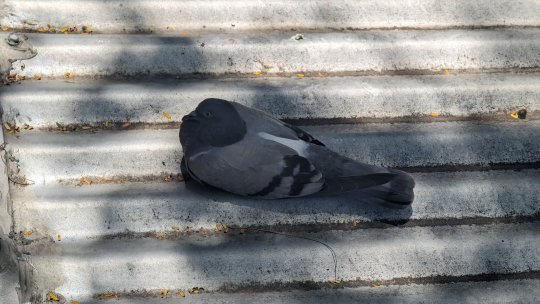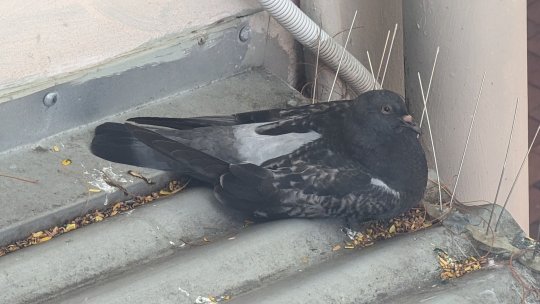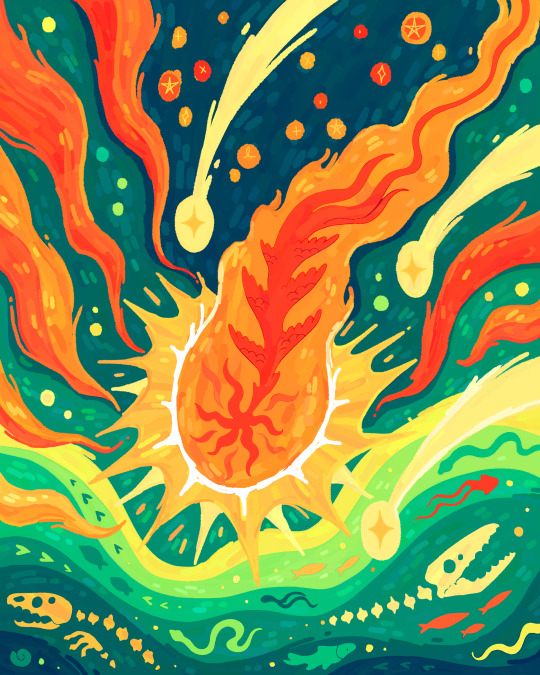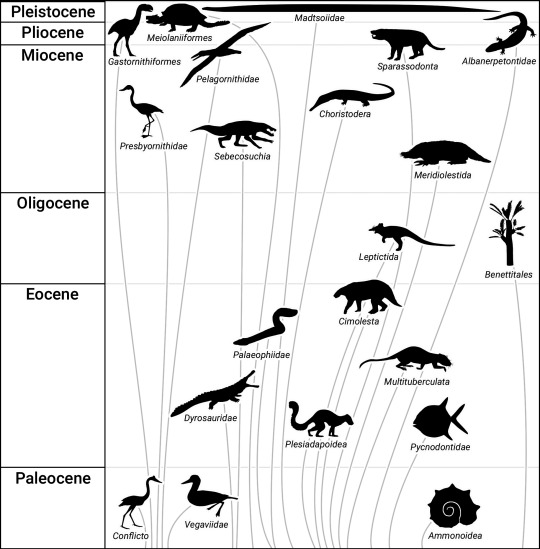#(Cretaceous-Paleogene extinction event)
Explore tagged Tumblr posts
Text
The Katie Extinction event happened because a barista put the wrong name on a cup
#kt Extinction event#Cretaceous–Paleogene extinction event#k-t extinction event#kpg Extinction event#k-pg Extinction event#Cretaceous-Tertiary Extinction#barista#Starbucks
9 notes
·
View notes
Text

The wonderful inhabitants of the salt lake basin in early periods.
#vintage illustration#dinosaurs#reptiles#paleontology#science#cretaceous–paleogene extinction event#cretaceous period#late cretaceous#pre-scientific history#evolution#paleobiology#paleogene period#fossils
19 notes
·
View notes
Text
turned 30 today #whack
17 notes
·
View notes
Text
avian dinosaurs 👇


#pigeon#sure the cretaceous-paleogene extinction event was bad but at least we got pigeons out of it#best birbs#rock dove
8 notes
·
View notes
Text
Yes!! This! And I love that they have such dramatic names, too — the Oxygen Catastrophe is great, and the End-Permian Mass Extinctions is colloquially known as the Great Dying.
end permian mass extinction...at least we don't have to deal with "Lava sea the size of Saudi Arabia"
#for context the one that killed the dinosaurs is as far as I know only known as the KPG Extinction Event#(Cretaceous-Paleogene extinction event)#these are THAT MUCH more dramatic than it#anyway I love talking about these they’re insane#and in todays climate (cultural and literal) I think it’s very important that we have a sense of extinction events in the past#I feel like people have this sense that if we don’t stop emissions all life on earth will die#which is just. totally wrong.#as seen above there have been far worse cases before#like. we have not nearly reached ‘all of siberia is covered in lava and it’s setting the ground on fire’ levels of bad#(that is the saudi-arabia sized lava mentioned by op I believe)#and there have been many terrible disasters for life on earth in the past#and in each and every case huge amounts of fascinating and beautiful life and diversity have been permanently lost#but also in each and every case life has recovered#and come back in ways so different and beautiful and unexpected that it could hardly have been imagined before the extinction#we wouldn’t BE here if it weren’t for all of that#and just in general… it’s wild how much earth has changed!!!#so much has happened in our past!!!!#I learned in the last few months that grasslands have only existed since after the kpg extinction!!!#flowering plants only came to be in the Cretaceous!!!#no stegosaurus ever saw a flower!!!!!#MAMMALS are older than flowering plants#so are sharks#also#once upon a time the earth was patrolled by dog-sized millipedes#not enough people know about that#phew. all right. I’ll stop.#ok tag rant over now lol#wren talks#natural history#science
4K notes
·
View notes
Text

Old paleoart, April 13, 2019. The title was 'Sobrevivientes del Frio'. I accidentally made the perspective very skewed and made the protagonist of this image look much bigger than he really is; I want to remake it one day.
'Around 65 million years ago. The Danian stage of the Paleocene. Near what is now Cambrils, Spain.
After a lakeshore forage, a tiny Hainina pyrenaica yawns, near to the scattered remains of a Coelodus laurenti fish, washed in from deeper waters.
This scene takes place less than a million years after the Cretaceous-Paleogene extinction event (66.043 million years ago), which devastated Earth and wiped out much of the megafauna, including non-avian dinosaurs and most aquatic reptiles. As with many extinction events, smaller and hardier creatures are less affected, and those few small, hardy survivors are ancestral to the megafauna of the coming age.
Close congeners of both Hainina and Coelodus were already present before the extinction and prevailed after it. No matter how terrible a tragedy is, life will find a way out.'
114 notes
·
View notes
Text

Postcard illustration for the Angelology IV campaign. I tried something new and made this one in a lineless style.
For this piece I was inspired by the Chicxulub Asteroid, which caused the Cretaceous-Paleogene extinction event - aka. extinction of the dinosaurs.
When I learned about it, it was in the context of learning about the K-T boundary, a geological marker with high iridium levels. I think it's very cool that we can see such an impactful event in the geological record across the world. I was even lucky enough to visit a site where I could see the boundary in-person! This was back when I was studying geology. All part of my complex and mysterious backstory ahahahaha! Anyway, rocks are cool, and I hope you like my artwork.
#angelology#angelology iv#angelology iv: angels of extinction#angel#angels#eldritch angel#eldritch angels#biblically accurate angel#biblically accurate angels#angelcore#angel art
287 notes
·
View notes
Text
Why Did Dinosaurs Go Extinct While Some Life Survived?
About 66 million years ago, a massive disaster called the Cretaceous-Paleogene (K-Pg) extinction event struck Earth, wiping out roughly 75% of all species, including all non-avian dinosaurs like Tyrannosaurus rex and Triceratops. While these famous dinosaurs disappeared, other groups—such as birds, mammals, and some reptiles—managed to survive.
20 notes
·
View notes
Text
Quaternary includes both the Pleistocene and Holocene extinction pulses, even though the first may not be entirely anthropogenic
I’m not including the great oxygenation event because that is the least clear in terms of whether or not it actually was an extinction
540 notes
·
View notes
Text
Ok well it took a stupid amount of time (several hours!!!) but the blog has been cleaned up. I mostly kept any substantial headcanon asks, posts, random essays and other stuff in that general category. Those posts are now under the tag #archive. So for people who are here for headcanons, those should be extremely easy and mostly clutter-free to find now (though I probably missed some, and some posts more than likely got axed by mistake, I didn't go through the effort to click on every single thing to see what it was).
Not sure what the activity level will be here going forward? I'll definitely answer asks, haven't made a decision on pretty much anything else lol. I'll be posting my OCs elsewhere and that blog will be announced here whenever i get the worldbuilding to a point that I can actually start doing it! (worldbuilding is NOT simple if you're a science and accuracy freak like me. ive spent the whole week learning about plate tectonics and hadley cells and the function of ocean currents and the Cretaceous-Paleogene extinction event and the chemistry of the ozone layer. and trying to figure out how the FUCK to make rats extinct. I hate it here)
Also, undecided verdict on the essay i have on Splatoon story modes. It's something I was originally going to make into a video essay, then decided not to, but it's something that definitely belongs on this blog so there's the chance I will, at some point, edit it into proper reading form and post it. But that would be a LOT to read so idk... undecided.
now i'm going to go make dinner because it's 6pm. somehow.
21 notes
·
View notes
Text
Quick addition to my paleontology analysis because I'm a nerd and I need to get across how fucking old Badboyhalo is!!!
Bad is at least as old as the Cretaceous-Paleogene (K-Pg/K-T) mass extinction! This is the extinction event that killed off all of the Non-Avian dinosaurs! In total, it killed about 60 to 70% of all species on earth! This happened around 66 million years ago!
Bad is also possibly as old as the Permian-Triassic mass extinction, then he would have also been around for the Triassic-Jurassic mass extinction event. This extinction event killed off about 80% of all species on earth! It happened around 201.3 million years ago!
Bad might be as old as the Permian-Triassic mass extinction event! This extinction event killed off about 90% of all species on earth! It is the largest known mass extinction event! This happened around 251.9 million years ago!
That is at least one mass extinction event that Bad would have been around for!!!
54 notes
·
View notes
Text

Specposium's Spectember day 27: Revamp the dinosauroid
The dinosauroid was a dinosaur species created by Dale A. Russell in 1982. Russell theorized that if a dinosaur such as Stenonychosaurus had not perished in the Cretaceous–Paleogene extinction event, its descendants might have evolved to fill the same ecological niche as humans. Or in other words sapient dinosaurs. It was very anthropocentric and had a human-like bodyplan, something doubtful.
So here we have my take on the dinosauroid, a small theropod with digging habits. It is very smart because it has a complex social system and also need to overcome its prey in their burrows and its predators. It has lost its arms as they weren't useful for digging instead evolving robust claws and a short body.
#specposium#spectember#spectember 2023#worldbuilding#art#illustration#spec bio#speculative biology#spec evo#speculative evolution#speculative zoology#creature concept#creature art#my art
123 notes
·
View notes
Text

MOTHER NATURE & THE CRETACEOUS-PALEOGENE EXTINCTION EVENT - aka, the asteroid that killed most of the dinosaurs.
i think i've gone into detail on this blog before about what happened to mother nature during that event -- tl;dr, it wounded her deeply on a physical level, and she had to lay dormant to heal right alongside the earth. she was in excruciating pain, and she had to "grow back", starting from her skeleton, then her muscles, etc. it was a gruesome process, and one she did by herself. this physical pain was nothing next to her emotional pain, as she had to endure feeling and watching her children die. before it was confirmed that mother nature had control over gravity (we stan an op queen 💚), it was easy to write this event off as a tragedy that was out of her control. but once that power was confirmed, i didn't really know how to reconcile this? like logically, she would've tried to kick away that asteroid the second she knew it was coming. so what happened...? headcanon time! while mother nature does command gravity, it is still gravity, meaning she was forced with an impossible choice when she knew that asteroid was coming: a) use an extreme force of gravity to knock the asteroid off its path, which would prevent it from impacting the earth! but it would absolutely knock the earth off of its delicate orbit around the sun, which would present... an entirely different, horrible situation. one where her children would absolutely still die, just slowly. b) let the asteroid hit the earth, have a mass extinction event, but! have the hope of regrowing, orbit intact. she ultimately chose the latter, since she technically wasn't on the earth when its orbit was solidified (hello heavy bombardment period), so orbit creation was honestly not something she felt she wanted to experiment with on her own planet and risk ruining the earth forever by depriving it of its goldilocks position. but even though this was an impossible choice, she of course blames herself every day. she thinks she chose the wrong option by picking the "coward's route."
#|| ⚘ FOR NOW IT IS MY TURN TO HOLD THE PEN. ( headcanon )#( don't....look too closely at this scientifically pls. )#( i just needed a band-aid to cover this plot hole. )#( so before anyone says 'um actually' pls. i beg u. i am stupid and this is a character from a kid's book. )
8 notes
·
View notes
Text

Chart with PhyloPic silhouettes from an essay in the upcoming comic book, Paleocene #4. These are lineages that survived the Cretaceous–Paleogene extinction event but died out before the Holocene Epoch (which is almost too brief to be visible here—it is a thin sliver atop the Pleistocene). Figures are not to scale, and do not line up perfectly to lineage extinction dates, just to epochs. This chart is available under the CC BY-SA 3.0 license.
For more information about the silhouettes in the chart, see: https://www.phylopic.org/.../7dc1ae186d11d8c2ad9f502fc47d...
For more about the comic book, see https://www.kickstarter.com/projects/keesey/paleocene-4-comic-book
#extinction#paleontology#dinosaur#paleoart#palaeontology#prehistoric#biology#zoology#botany#extinct animals#extinct species#extinct birds#cenozoic#sciart#palaeoblr#deep time#geologic time
73 notes
·
View notes
Text

August's Fossil of the Month - Gastornis (Gastornis spp.)
Family: Gastornis Family (Gastornithidae)
Time Period: Early Paleogene (55-40 Million Years Ago)
Roughly 66 million years ago, the Cretaceous period ended in a sudden mass extinction event known as the Cretaceous-Paleogene Extinction Event in which as many as 75% of all terrestrial animal and plant species went extinct, with the vast majority of large animals (specifically most species weighing more than 25kg/55lbs, including all non-avian dinosaurs) being among the most notable losses. Following this massive plummet in biodiversity the relatively small number of species that survived into the earth's next geological period, the Paleogene, were left to "inherit the earth", and as environmental conditions stabilised and the surviving plant species began to diversify and become more prominent, an increase in the availability of food allowed the descendants of the extinction event's survivors to gradually grow to larger sizes. The members of the genus Gastornis are examples of animals that took advantage of this new opportunity; thought to be descended from small duck or pheasant-like animals, Gastornis species were enormous flightless birds (with the largest species, Gastornis gigantea, growing to be up to 2 meters/6.5 feet tall) with long legs and muscular necks supporting huge, powerful beaks, the purpose of which has been the subject of extensive debate - historically it was suggested that the presumably powerful legs and bill of Gastornis species were adaptations that aided them in pursuing, catching and killing the many smaller herbivorous mammals with which they coexisted, but following the discovery of more complete fossils (which show that species in this genus lacked the powerful claws and sharp-tipped beak seen in most modern carnivorous birds, and which contained trace minerals more common in the bones of herbivores than those of carnivores,) it is now generally believed that Gastornis species were likely herbivorous, with their huge beaks allowing them to break open hard-shelled fruits and seeds in a manner comparable to that seen in modern macaws and cockatoos. Gastornis fossils have been found across Asia, Europe and North America (having presumably used land bridges to spread between continents,) all of which would have been warmer and more humid than today at the time, allowing for the growth of dense rainforests that would have provided abundant food for a large browsing herbivore; as the Paleogene period progressed the climate became progressively warmer and drier and rainforests became rarer, likely contributing to the eventual extinction of Gastornis species. The name Gastornis translates roughly to "Gaston's Bird", honouring the French physicist Gaston Planté who is credited with having discovered the first known Gastornis fossils in a mine in Meudon, France in 1855.
--------------------------------------------------------------------------Image Source: tps://commons.wikimedia.org/wiki/File:Gastornis,_a_large_flightless_bird_from_the_Eocene_of_Wyoming.jpg
#gastornis#zoology#biology#ornithology#paleontology#wildlife#prehistoric wildlife#animal#animals#bird#birds#prehistoric animals#Asian wildlife#North American wildlife#European wildlife
69 notes
·
View notes